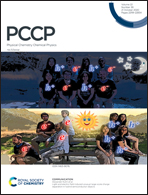Insights into the mechanism of the enhanced visible-light photocatalytic activity of a MoS2/BiOI heterostructure with interfacial coupling†
Abstract
An understanding of the high photocatalytic performance reported for MoS2/BiOI nanocomposite is far from satisfactory. Here, the interfacial interaction and electronic properties of a MoS2/BiOI heterostructure were investigated systematically for the first time by first-principle calculations incorporating a semi-empirical dispersion-correction scheme. Our results confirm the reasonable existence of van der Waals interactions and a favorable Z-scheme mechanism, based on the typical interfacial cohesive energy and the energy level lineup at the interface. Analyzing the charge density differences and work functions, the built-in electric field is formed along the direction from MoS2 to BiOI after the interface equilibrium, and facilitates the separation of photoinduced electron–hole pairs in the interface. Additionally, it can be inferred that the incorporation of MoS2 into BiOI increases the carrier mobility and improves light harvesting, in agreement with the previously reported experimental data. Our work provides an insight into the mechanism of the enhanced visible-light photocatalytic activity of a MoS2/BiOI heterostructure, and helps to design other new heterostructure combinations.



 Please wait while we load your content...
Please wait while we load your content...